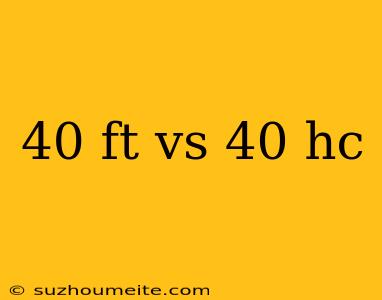40 FT vs 40 HC: What's the Difference?
When it comes to shipping containers, understanding the differences between 40 FT and 40 HC is crucial for efficient and cost-effective logistics. Both types of containers are commonly used for international shipping, but they have distinct characteristics that set them apart. In this article, we'll explore the key differences between 40 FT and 40 HC containers to help you make informed decisions for your shipping needs.
What does FT and HC stand for?
Before diving into the differences, let's quickly cover what FT and HC stand for:
- FT: Feet, referring to the length of the container in feet.
- HC: High Cube, referring to the height of the container.
40 FT Container
A 40 FT container is a standard shipping container with an internal length of 40 feet (12.19 meters), width of 8 feet (2.44 meters), and height of 8 feet 6 inches (2.59 meters). This container type is ideal for shipping bulky or heavy cargo that requires more volume than a 20 FT container but doesn't require the extra height of a High Cube container.
Pros of 40 FT Container:
- Cost-effective: 40 FT containers are generally cheaper than 40 HC containers.
- Wide availability: 40 FT containers are widely available and easy to find.
- Easy to handle: They are easier to handle and move around due to their standard size and weight.
Cons of 40 FT Container:
- Limited height: The 8 feet 6 inches height may not be suitable for shipping taller or bulkier cargo.
- Lower payload capacity: 40 FT containers have a lower payload capacity compared to 40 HC containers.
40 HC Container
A 40 HC container is a High Cube container with an internal length of 40 feet (12.19 meters), width of 8 feet (2.44 meters), and height of 9 feet 6 inches (2.90 meters). This container type is ideal for shipping cargo that requires more vertical space, such as palletized goods, machinery, or construction equipment.
Pros of 40 HC Container:
- Increased payload capacity: 40 HC containers have a higher payload capacity compared to 40 FT containers.
- Taller cargo: They can accommodate taller or bulkier cargo that wouldn't fit in a standard 40 FT container.
- Better ventilation: The extra height provides better ventilation and reduces the risk of cargo damage.
Cons of 40 HC Container:
- Higher cost: 40 HC containers are generally more expensive than 40 FT containers.
- Limited availability: They may be harder to find and more difficult to handle due to their larger size.
Conclusion
In conclusion, 40 FT and 40 HC containers serve different purposes and are suited for specific shipping needs. When choosing between the two, consider the type of cargo, its dimensions, and the required payload capacity. If you need to ship bulky or heavy cargo that fits within a standard height, a 40 FT container might be the better choice. However, if you require extra vertical space for taller or bulkier cargo, a 40 HC container is the way to go. By understanding the differences between these two container types, you can optimize your shipping operations and reduce costs.
